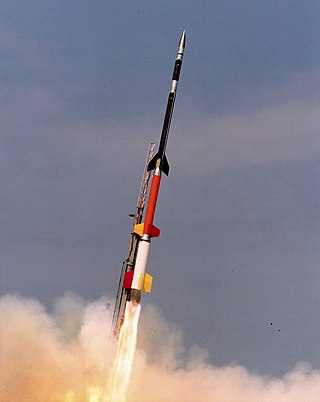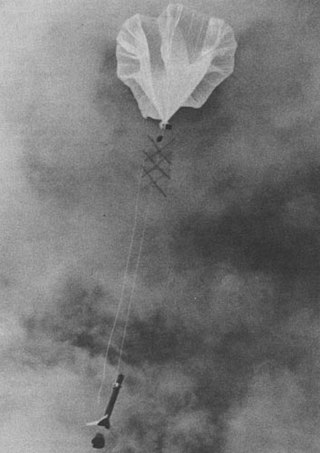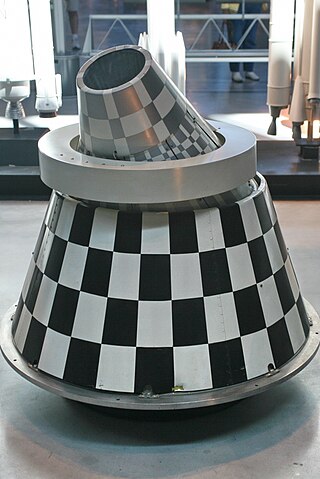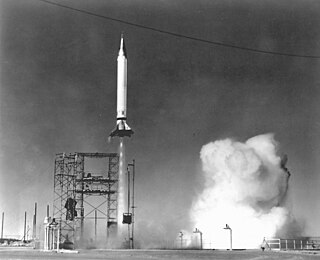Project Vanguard was a program managed by the United States Navy Naval Research Laboratory (NRL), which intended to launch the first artificial satellite into low Earth orbit using a Vanguard rocket as the launch vehicle from Cape Canaveral Missile Annex, Florida.

The Aerobee rocket was one of the United States' most produced and productive sounding rockets. Developed by the Aerojet Corporation, the Aerobee was designed to combine the altitude and launching capability of the V-2 with the cost effectiveness and mass production of the WAC Corporal. More than 1000 Aerobees were launched between 1947 and 1985, returning vast amounts of astronomical, physical, aeronomical, and biomedical data.

James Alfred Van Allen was an American space physicist at the University of Iowa. He was instrumental in establishing the field of magnetospheric research in space.

A sounding rocket or rocketsonde, sometimes called a research rocket or a suborbital rocket, is an instrument-carrying rocket designed to take measurements and perform scientific experiments during its sub-orbital flight. The rockets are used to launch instruments from 48 to 145 km above the surface of the Earth, the altitude generally between weather balloons and satellites; the maximum altitude for balloons is about 40 km and the minimum for satellites is approximately 121 km. Certain sounding rockets have an apogee between 1,000 and 1,500 km, such as the Black Brant X and XII, which is the maximum apogee of their class. For certain purposes Sounding Rockets may be flown to altitudes as high as 3,000 kilometers to allow observing times of around 40 minutes to provide geophysical observations of the magnetosphere, ionosphere, thermosphere and mesosphere. Sounding rockets have been used for the examination of atmospheric nuclear tests by revealing the passage of the shock wave through the atmosphere. In more recent times Sounding Rockets have been used for other nuclear weapons research. Sounding rockets often use military surplus rocket motors. NASA routinely flies the Terrier Mk 70 boosted Improved Orion, lifting 270–450-kg (600–1,000-pound) payloads into the exoatmospheric region between 97 and 201 km.

A sub-orbital spaceflight is a spaceflight in which the spacecraft reaches outer space, but its trajectory intersects the surface of the gravitating body from which it was launched. Hence, it will not complete one orbital revolution, will not become an artificial satellite nor will it reach escape velocity.
The Vanguard rocket was intended to be the first launch vehicle the United States would use to place a satellite into orbit. Instead, the Sputnik crisis caused by the surprise launch of Sputnik 1 led the U.S., after the failure of Vanguard TV-3, to quickly orbit the Explorer 1 satellite using a Juno I rocket, making Vanguard 1 the second successful U.S. orbital launch.
Lockheed Martin Space is one of the four major business divisions of Lockheed Martin. It has its headquarters in Littleton, Colorado, with additional sites in Valley Forge, Pennsylvania; Sunnyvale, California; Santa Cruz, California; Huntsville, Alabama; and elsewhere in the United States and United Kingdom. The division currently employs about 20,000 people, and its most notable products are commercial and military satellites, space probes, missile defense systems, NASA's Orion spacecraft, and the Space Shuttle external tank.

A rockoon is a sounding rocket that, rather than being lit immediately while still on the ground, is first carried into the upper atmosphere by a gas-filled balloon, then separated from the balloon and ignited. This allows the rocket to achieve a higher altitude, as the rocket does not have to move under power through the lower and thicker layers of the atmosphere. A 2016 study by Acta Astronautica concluded that low-mass and high altitude launches give the best results.

The first orbital flight of an artificial satellite, Sputnik 1, was launched in October 1957, by the Soviet Union. In November, the second orbital flight took place. The Soviet Union launched the first animal to orbit the Earth, a dog, Laika, who died in orbit a few hours after launch.

Spaceflight as a practical endeavor began during World War II with the development of operational liquid-fueled rockets. Beginning life as a weapon, the V-2 was pressed into peaceful service after the war at the United States' White Sands Missile Range as well as the Soviet Union's Kapustin Yar. This led to a flourishing of missile designs setting the stage for the exploration of space. The small American WAC Corporal rocket was evolved into the Aerobee, a much more powerful sounding rocket. Exploration of space began in earnest in 1947 with the flight of the first Aerobee, 46 of which had flown by the end of 1950. These and other rockets, both Soviet and American, returned the first direct data on air density, temperature, charged particles and magnetic fields in the Earth's upper atmosphere.

Atlas is a family of US missiles and space launch vehicles that originated with the SM-65 Atlas. The Atlas intercontinental ballistic missile (ICBM) program was initiated in the late 1950s under the Convair Division of General Dynamics. Atlas was a liquid propellant rocket burning RP-1 kerosene fuel with liquid oxygen in three engines configured in an unusual "stage-and-a-half" or "parallel staging" design: two outboard booster engines were jettisoned along with supporting structures during ascent, while the center sustainer engine, propellant tanks and other structural elements remained connected through propellant depletion and engine shutdown.

Space Systems Command (SSC) is the United States Space Force's space development, acquisition, launch, and logistics field command. It is headquartered at Los Angeles Air Force Base, California, and manages the United States' space launch ranges.

The Missile Defense Alarm System, or MIDAS, was a United States Air Force Air Defense Command system of 12 early-warning satellites that provided limited notice of Soviet intercontinental ballistic missile launches between 1960 and 1966. Originally intended to serve as a complete early-warning system working in conjunction with the Ballistic Missile Early Warning System, cost and reliability concerns limited the project to a research and development role. Three of the system's 12 launches ended in failure, and the remaining nine satellites provided crude infrared early-warning coverage of the Soviet Union until the project was replaced by the Defense Support Program. MiDAS represented one element of the United States's first generation of reconnaissance satellites that also included the Corona and SAMOS series. Though MIDAS failed in its primary role as a system of infrared early-warning satellites, it pioneered the technologies needed in successor systems.

This is a list of spaceflight related events which occurred in 1956.

In 1955, both the United States and the Soviet Union (USSR) announced plans for launching the world's first satellites during the International Geophysical Year (IGY) of 1957–58. Project Vanguard, proposed by the US Navy, won out over the US Army's Project Orbiter as the satellite and rocket design to be flown in the IGY. Development of Intercontinental Ballistic Missiles, the Atlas by the US and the R-7 by the USSR, accelerated, entering the design and construction phase.

In 1952, several branches of the United States' military, often in partnership with civilian organizations, continued their programs of sounding rocket research beyond the 100 kilometres (62 mi) boundary of space using the Aerobee rocket. The University of Iowa launched its first series of rockoon flights, demonstrating the validity of the balloon-launched rocket, a comparatively inexpensive way to explore the upper atmosphere. The launch of Viking 9 at the end of the year to an altitude of 135 mi (217 km), by the Naval Research Laboratory team under the management of Milton Rosen, represented the pinnacle of contemporary operational rocket design.

The year 1951 saw extensive exploration of space by the United States and the Soviet Union (USSR) using suborbital rockets. The Soviets launched their first series of biomedical tests to the 100-kilometre (62 mi) boundary of space. Several American agencies launched more than a dozen scientific sounding rocket flights between them. The US Navy launched its Viking sounding rocket for the seventh time since 1949, this time to a record-breaking 136 miles (219 km) in August 1951.

Milton William Rosen was a United States Navy engineer and project manager in the US space program between the end of World War II and the early days of the Apollo Program. He led development of the Viking and Vanguard rockets, and was influential in the critical decisions early in NASA's history that led to the definition of the Saturn rockets, which were central to the eventual success of the American Moon landing program. He died of prostate cancer in 2014.

The year 1953 saw the rockoon join the stable of sounding rockets capable of reaching beyond the 100 kilometres (62 mi) boundary of space. Employed by both the University of Iowa and the Naval Research Laboratory, 22 total were launched from the decks of the USS Staten Island and the USCGC Eastwind this year. All branches of the United States military continued their program of Aerobee sounding rocket launches, a total of 23 were launched throughout 1953. The Soviet Union launched no sounding rockets in 1953; however, the Soviet Union did conduct several series of missile test launches.

















